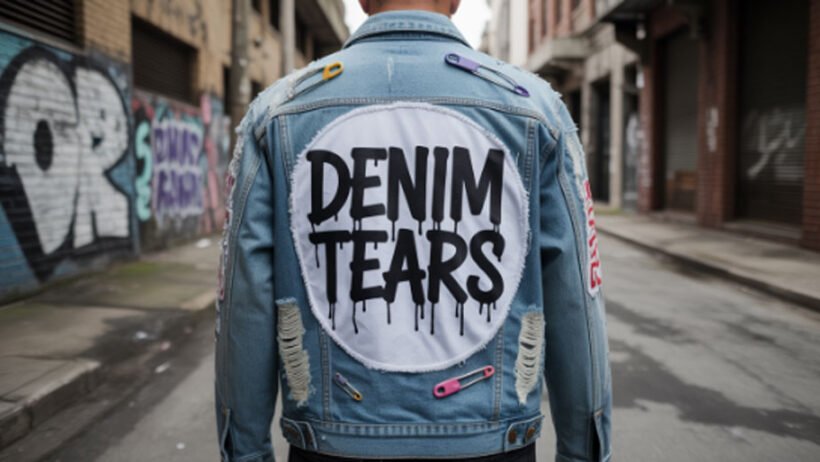Denim Tears was started in 2019 by Tremaine Emory, a cultural force famous for his deep date with skill, fashion, and Black history. Unlike many fashion brands compelled solely by style or migratory trends, Denim Tears was created as a form of protest, a poetic answer to systemic bias, and a visual representation of African-American correspondence and resilience. Emory’s work as an imaginative consultant and old creative manager of Supreme added believability, but it was his impassioned and intellectual approach to storytelling that doubtlessly set Denim Tears apart.
Cotton as a Symbol of Resistance
At the center of Denim Tears is cotton, not solely as a textile, but as a historical character. One of the brand’s most recognizable pieces is the understated wreath pattern printed on denim jeans, jackets, and hoodies. This design is intoxicated with typology. It references the rough history of African-American slavery, where cotton production was both a way of economic growth and human exploitation. Emory uses this iconography not while a reminder of ancient times but also as a reclamation of tradition. In his globe, cotton is not any more just a crop—it’s a canvas for truth.
Storytelling Through Streetwear
Denim Tears doesn’t just peddle clothes—it tells stories. The collections are often followed by essays, artworks, and visual installations that expand the narrative. From collaborations with organizations like the Smithsonian to capsule collections joined with Juneteenth, every release accomplishes meaning. The robe is a wearable history lesson, destined to educate the wearer and spark conversations in a fuller society. This reading approach positions Denim Tears closer to cultural analysis than commercial fashion.
Collaborations That Reinforce the Mission
Denim Tears has conspired with an assortment of brands, including Levi’s, Converse, Ugg, and Dior. These partnerships are not simply for hype or profit. Instead, they present an image of amplifiers for Emory’s message. The 2020 Levi’s x Denim Tears capsule, for instance, explicitly confronted the heritage of slavery and allure ties to American capitalism. With Converse, Emory arranged sneakers that merged the classic Chuck Taylor outline with African-American needlepoint traditions and tribal references.
In each case, Emory uses these cooperations to reach audiences that might not usually engage with accompanying critical historical tales. The garments, though fashionable, are bowls of memory, analysis, and aspiration.
The Personal Is Political
For Emory, Denim Tears are individual. His own experiences as a Black husband in America, his knowledge of diasporic past, and his date with public issues all inform the brand’s route. The brand’s name itself—“Denim Tears”—evokes an emotional state, a mourning for that reason has been extinct, and a resilient pride for that reason has been reclaimed.
This poignant core changes the brand in an industry frequently dominated by superficial aesthetics. Denim Tears is not driven by profit borders or trend phases; it’s driven by purpose. Even allure irregular release schedules mirror this—new pieces come out not to equal fashion calendars, but to mark moments in educational time.
Fashion as a Tool of Liberation
In many habits, Denim Tears echoes the legacy of artists and intellectuals who have secondhand creative expression by way of resistance. Just as James Baldwin drafted to confront racism or Nina Simone intoned to reflect the occasions, Emory designs with intention. His brand invites wearers to degrade what they are putting on and reason.
Fashion has long existed as a tool of similarity, but in the case of Denim Tears, it becomes a tool of freedom. The clothes serve as shields and declarations, protecting the excellence of their wearers while publicly insisting on a collective history that is often removed or sanitized.
Criticism and the Challenge of Authenticity
Of course, operating in the marketing fashion space while aggressive, such a heavy meaning comes with allure’s own set of contradictions. Critics have requested whether partnering with accompanying luxury fashion apartments dilutes the potency of Emory’s responsibility. Others question the accessibility of the brand, with restricted releases and high resale prices constantly excluding the very societies it aims to represent.
Emory appears aware of these pressures and addresses them in interviews and public talks. His stance has frequently been that a date with the best platforms—though imperfect—is necessary to shift the discourse. For him, occupying space inside major fashion networks is a form of ruin, a way to introduce radical thought into otherwise apolitical arenas.
Beyond Fashion: A Cultural Movement
Denim Tears surpasses the label of “fashion brand.” It functions more like a multidisciplinary enlightening movement, collecting history, identity, government, and aesthetics. Its visual identity—combining archival photography, handwritten notes, and archival texts—resembles a living museum. The brand’s Instagram feed is as likely to reveal James Baldwin or bell hooks as it searches out a new product drop.
In this way, Denim Tears creates a layered knowledge where clothing enhances entry points into much larger dialogues. It’s a reminder that fashion can be both beautiful and intellectually severe, capable of honoring ancient times while imagining new futures.
Conclusion:
As Tremaine Emory resumes to shape the identity of Denim Tears, the brand’s future is rooted in deeper education, fuller collaborations, and further testing. Whether through physical exhibitions, mathematical storytelling, or governmental organizing, Denim Tears is poised to evolve as more than a brand—it’s a flow toward recontextualizing Black narratives fashionably.





